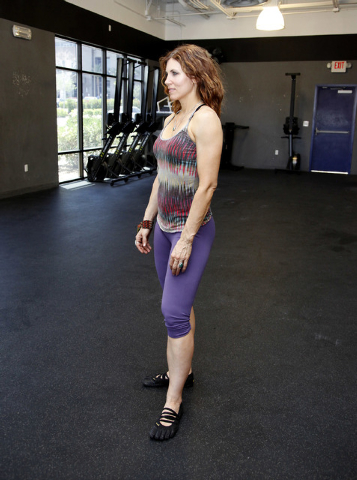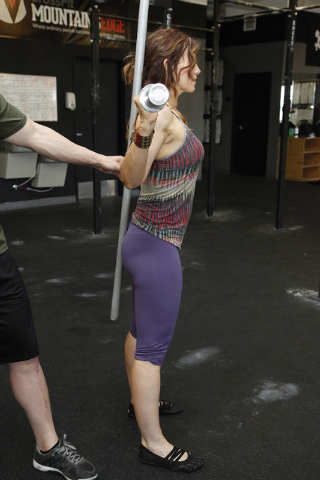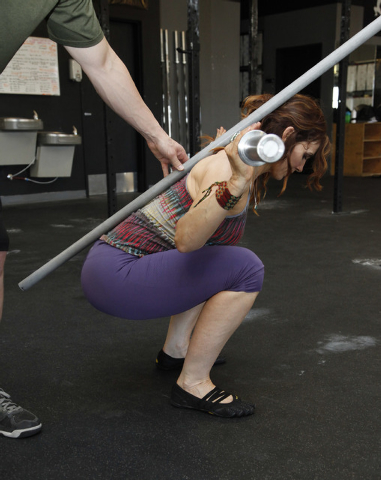Standing and squats can help nurses
What you do for a living can affect your overall fitness. This is the first in a series of occupation-specific columns to help various workers feel and perform better on the job.
Nurses have a demanding career. At most Las Vegas hospitals nurses work three 12-hour shifts in one week. This is to maintain continuity of care for the patients.
Some have the traditional five eight-hour shifts, but most are required to do the three 12s.
Nurses provide care for a varying number of patients. On a slow shift, they may get a few patients admitted and discharged, while also caring for those who remain.
During busier shifts, they may be dealing with full beds and patient visits that last days or weeks. Between checking in regularly with patients, conversing with doctors about the specifics of their care, and pushing a computer cart around, nurses are constantly moving. It is rare to see a nurse idly sitting.
You might be surprised to know how much lifting nurses do in a shift. Helping patients of varying size and physical ability in and out of bed and chairs can be quite taxing. Sometimes the nurse acts as a spotter for such a transition; other times it takes a few nurses working together to gently lift patients.
Las Vegas nurse Maureen Wozniak gave me some insight into the physical demands and body mechanics nurses face.
Many of them wear some kind of compression socks or leg sleeves. This helps blood flow to and from the legs. Without the compression socks, nurses can expect swollen ankles and achy feet from being on the move an entire shift.
I asked Maureen what recurring pains nurses have after being on the job for a while. She said low-back and/or knee pain are common. As a trainer, when I hear that someone has low-back pain, I immediately think of core strength. That is after making sure they don’t have a more serious condition in which exercise and movement are limited by a physician.
Often if the core is not active, the spine just flops to whatever position doesn’t hurt at that moment. This tugs some back muscles and shortens others. Over time, this can lead to muscle imbalances, and possibly to painful posture issues.
A tight core can help keep the spine in a better position. In constantly caring for patients, nurses let their own posture fall a few notches on the priority list. Also, holding a tight core for an entire eight- to 12-hour shift is tough. Nurses almost need to be endurance gymnasts (if there are such things) to hold a core that tight for that long.
The first exercise I have to help the core is to practice standing. Yes, standing. I know it sounds super remedial, but it works. The difficult part is to remember to do it. Standing so the core is braced and the body is neutral will do wonders.
Think of how you stand when you are tired. One foot is off to the side and you lean on the other. The pelvis is tilted. Maybe you even lean on the wall or a chair. One hand may be on a hip to help hold the spine up. The head may be tilted to one side or looking down. Are the shoulders back? Probably not. This twisted standing position may not be the most effective in preventing back or knee pain.
Contrast the tired posture to the braced standing posture featured today. The nice thing about the braced posture is that a person doesn’t need to hold a maximum contraction; just enough to maintain a stable position. The entire body shares the load, not just the core. The glutes, core and even the shoulders get involved.
As you begin learning to squat, you see bad squats everywhere. It opens your eyes to faults that may lead to injury. Maureen, being an athlete with ever-increasing back squat strength and mechanics, tells me that she sees faulty squat (bending) mechanics daily — from lifting objects and patients to picking things off the floor (technically a dead lift). Knees crash in, backs round and knees are overloaded.
I recommend squatting for nurses. However, let’s change the focus to be career-specific. Instead of squatting for increasing weights, I recommend squatting to controllably stress the body’s frame. This will help condition the body to be comfortable with proper squat mechanics that will become second nature, even when you’re tired and going into the 12th hour of your shift.
Work on getting that squat in as near perfect form as possible. Perfect form in the gym will transfer to the job. Good squat mechanics mean your core is strong enough to hold itself and a barbell for a few reps. The stronger your squat, the stronger your core.
Varying the kind of squat stress your body is exposed to will have different effects. Perform three to five sets of anywhere from five to 12 repetitions with different loads and tempos. More sets (four to five) with more reps (10 to 12) and a slower tempo (slow down and fast up) will help build connective tissue strength. This will do wonders for general aches and pains in knees and the back. Fewer sets (two to three) with fewer reps (one to five) with faster tempo (controlled on the way down and fast up) will help build overall strength.
Give some priority to the mobility aspect of the squat. If you can’t get below the point where your thighs are parallel to the floor or your back arches too much, spend some time on the foam roller and doing some stretches. (See my earlier columns on different rolling and stretching techniques at lvrj.com/trainer.)
Get a trainer to teach you how to squat. Their experience and calibrated eye will help you squat well. Before long, your body will be better able to deal with your daily challenges.
Nursing is a demanding profession. Improving core stability and basic lift mechanics will make the physical demands easier.
Chris Huth is a Las Vegas trainer and can be contacted at 702trainer@gmail.com. Before beginning any exercise program, consult your physician.































